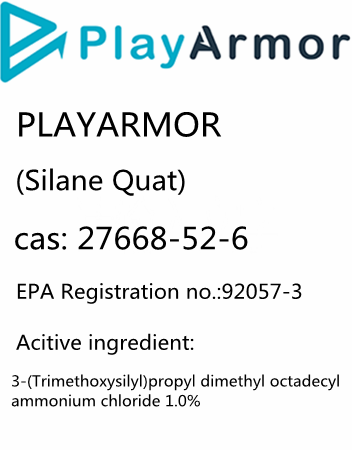PLAYARMOR,Silane Quat,CAS:27668-52-6
PlayArmor is the first antimicrobial coating specifically introduced in the recreation industry that protects playground equipment
and site amenities. It was created by biochemists and has been registered for use by the US Environmental Protection Agency (EPA).
Brand Name: PLAYARMOR
EPA Registration no.:92057-3
Synonyms:
Silane Quat,Quat Silane,SiQAC,SiQuat,A Silicone Quaternary Ammonium Salt,3-(Trimethoxysilyl)propyl dimethyl octadecyl ammonium chloride,3-(Trimethoxysilyl)propyldimethyl octadecyl ammonium chloride,3-(Trimethoxysilyl)propyldimethyloctadecyl ammonium chloride,3-(Trimethoxysilyl) propyldimethyloctadecyl ammonium chloride,PlayArmor Antimicrobial Coating
PlayArmor is:
– Clear
– Odorless
– Hypoallergenic
– Environmentally friendly
– Water-based
PLAYARMOR (Silane Quat,cas:27668-52-6) is scientifically proven to provide a barrier of antimicrobial protection that’s safe and
effective. Its active ingredient is effective against a broad spectrum of microbial activities with low toxicity to living cells.
When applied to a surface, positively charged ions adhere to a variety of surfaces resulting in a bacteriostatic antimicrobial
finish that inhibits the growth of microorganisms such as (odor-causing) bacteria, fungi, algae, mold, and mildew.
The active ingredient in PlayArmor forms an invisible, positively charged polymer which chemically bonds to the treated surface of a
playground or site furnishing. Think of this coating as a layer of electrically charged, microscopic swords that are imperceptible
to the touch.
When a microbe comes in contact with the treated surface, the swords puncture its cell membrane and an electrical charge shocks the
pathogen. The microbe is deactivated but PlayArmor maintains its effectiveness.
PLAYARMOR (Silane Quat,cas:27668-52-6) is a silane quat—a well-established class of antimicrobials —that provides a “mechanical
kill” of pathogens rather than a “chemical kill”. In effect, PlayArmor penetrates the cell wall of the pathogen by physically
rupturing its membrane and rendering it inactive.
Other antimicrobials on the market poison cells to kill them through leaching technology, creating the potential for the rise of
antimicrobial-resistant superbugs—a scenario not possible with PlayArmor’s technology.
NOTE: PLAYARMOR (Silane Quat,cas:27668-52-6) does not protect against airborne transmission of viruses. Mask wearing and social
distancing are still recommended per local requirements during indoor and outdoor play.
FREQUENTLY ASKED QUESTIONS (FAQ) of PLAYARMOR (Silane Quat,cas:27668-52-6)
Q: How often does PlayArmor need to be reapplied?
A: Application is recommended every 90 days, to remain effective. To maintain the highest level of effectiveness, normal cleaning
and disinfecting of treated playgrounds and site furnishings is necessary.
Q: Can PlayArmor be applied in cold climates?
A: PlayArmor may be applied when the ambient temperature is between 32°F and 122°F (0°C and 50°C). A heated tent can be used in
adverse cold conditions to reach the appropriate temperature range.
Q: Can I use PlayArmor for objects other than playground equipment, site amenities and playground surfacing?
A: No, PlayArmor is available only for application on these particular surfaces.
Q: Will PlayArmor contaminate the environment?
A: PlayArmor does not volatilize, dissipate, or leach onto other surfaces or into the environment. It is safe and EPA-registered.
Q: What is Active ingredient and EPA no. of PlayArmor?
A: PlayArmor is kind of Silane Quat with Acitive ingredient: 3-(Trimethoxysilyl)propyl dimethyl octadecyl ammonium chloride 1.0%;
CAS NO.:27668-52-6
EPA Registration no.:92057-3
